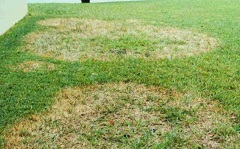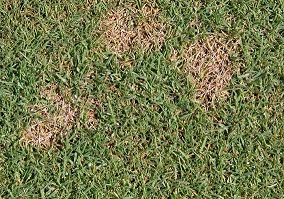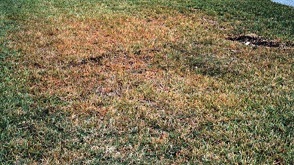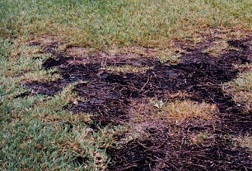What’s Wrong with my St. Augustine Grass?
The Yellow Yard–
About the time September rolls around, while the rainy season seems like it just will not end, some lawns may exhibit some yellowing. Grass seems healthy except for the tips turning bright yellow, concentrated where growth is most vigorous. This can be an iron deficiency caused by excessive watering, or too much rain, washing away nutrients during the most active growth periods for lawns. To remedy the yellow areas, you will need to apply a chelated (Key-late-ed) iron fertilizer to your lawn. But get out those reading glasses and find a comfortable spot to properly see the iron fertilizer’s fine print directions. Be sure to follow all package instructions exactly. Too much fertilizer can burn plants and is never a good thing.
Crop Circles, in my grass?
Circular brown patches could be one of several different things. If the circles are out by the sidewalk or street edges, and are smaller than twelve inches in diameter, this could be recurring dog urination. If your dog, or a neighbor’s dog, “goes” in the same spot repeatedly, be sure to water it in to dilute the concentrated urine to a more beneficial strength.
Mechanical Menace
Some irregular brown patches in the lawn may be due to repeatedly mowing your St. Augustine grass too short too often, especially during dry times. Plants make their food (sugars) in the leaf blades using sunlight. This is called photosynthesis. If the grass does not have enough leaf blades left for photosynthesis the grass will die. Raise the level of your mower to 4 or 5 inches for St. Augustine grass. If your mower will not go any higher and is still scalping the turf, try to replace the mower wheels with larger ones (greater diameter from the hub), creating more lift for the mow deck. If that is not a possibility it may be time to replace your mower with one which is friendlier to your lawn and allows for more height.
Irregular Irrigation
During prolonged drought, many lawns can exhibit large brown patches where the irrigation system does not reach. These thirsty areas of grass wither and brown, making them more susceptible to disease and insect damage. Drought could also see salt intrusion in irrigation wells. Salt water will damage most all grass lawns. See the UF/IFAS publication ENH-9, “Watering Your Florida Lawn” for best practices: ENH-9_Watering_Your_Florida_Lawn
Construction Chemistry
In lawns of new construction, brown areas may relate to soil pH issues resulting from sod roots finally growing deep enough into the underlying fill soil. Construction debris and mortar wash-out dumped during the construction process will change the underlying soil’s pH in that one area. The health of the sod in that area will differ from that of the rest of the lawn. This can also exhibit near newly poured concrete walkways, driveways, and foundations and will usually correct itself over time or with soil pH additives. Your local UF/IFAS Indian River County Extension office can do soil pH tests, usually for free. Call first for appointments or drop off your soil samples in our Indian River County Extension office lobby basket with your name and phone number.

The Fungus Among Us-
There are several fungal causes of brown circles. One is plainly called brown patch caused by the fungus Rhizoctonia, which also makes brown circles in the grass. These circles are usually larger than 12 inches. It can be treated with a fungicide for lawns and will recover. Dollar patch, or dollar spot, is another fungal

lawn ailment which makes numerous small three-inch brown circles in the lawn. Dollar patch is also treated with fungicide and should recover. Be sure to ALWAYS follow the fungicide package instructions exactly.

Fungicide Failure-
However, if there are brown patches in a properly watered and mown St. Augustine-grass lawn which are not circular, start out yellow and progress to brown, seem to be growing outward and which do not respond to fungicides, this is most likely Take-all root rot. This fungal turf

disease, Gaeumannomyces graminis var. graminis, will keep growing outwardly, taking large sections of lawn with it in an irregular pattern. Take-all root rot can destroy sizable areas of St. Augustine grass. For a definitive diagnosis, lawn samples may be sent to the University of Florida and must be still living yet exhibit some disease symptoms. The UF lab cannot tell what killed grass once it is dead. You can call your local UF/IFAS County Extension office for information on sending samples to the University of Florida for turf disease analysis.
The fungus causing Take-all root rot, as with other brown patches mentioned here, is most abundant during cool moist conditions, such as a wet winter. When conditions are right, the fungus covers the roots, stolons, rhizomes, and grass blades and crowns. The fungus then grows into the inner tissues and the brown patches become visible. Summer’s heat and heavy rains spread the fungus further.
Can I Prevent These Fungi in my Lawn?
Properly fertilized plants, including grasses, are less likely to become diseased and will look healthy. Nitrogen fertilizers have been shown to have a negative affect of the fungus which causes Take-all root rot. Nitrogen in ammonia form seems to diminish the disease but nitrogen in nitrate form is less effective. If you have a nitrogen fertilizer “blackout” period in effect in your area, as we do in Indian River County through the end of October, there is a way to get the same benefit with a combination of iron, magnesium, potassium (K), and manganese. Look for a product with an N-P-K ratio of “0-0-14” and with chelated or sulfate forms of the micro-nutrients iron (Fe), magnesium (Mg), and manganese (Mn).
A few fungicides which are effective in preventing Take-all root rot disease from occurring in your St. Augustine lawn include: Prostar ™, Heritage ™, and Compass ™. This should be used before the sod is laid or when expecting a wet cool spell when you know your lawn or a neighbor’s lawn have had the disease. Dead areas can be replaced with new sod and preventive treatment used on surrounding St. Augustine grass. And again, the label is the law. Always follow the package instructions EXACTLY.
For more information on Brown Patch, Large Patch disease in Florida lawns sodded with St. Augustinegrass, zoysiagrass, and others, The University of Florida’s Electronic Data Information Source (EDIS) has a short publication entitled, “Large Patch“.
Knowing what is wrong with an area of grass can be the biggest hurdle in keeping a green lawn. UF’s EDIS publication, “Turfgrass Disease Management” has detailed descriptions of most common turfgrass issues we will face here in Florida. Included are color photos of the problems and the simple solutions for those issues.
“Mowing Your Florida Lawn” is another very good EDIS publication which will give height and frequency recommendations, mower maintenance tips, good mowing practices, and troubleshooting common lawn mowing problems.
To learn more about the care of your St. Augustine grass lawn, please see the University of Florida’s EDIS publication, “St. Augustinegrass for Florida Lawns“.
 6
6
